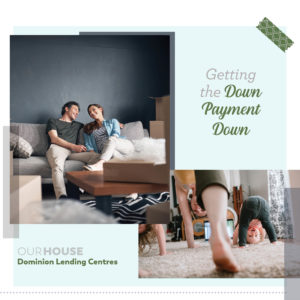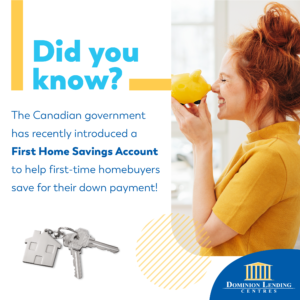
How much down payment do I need to purchase a home?
When purchasing your first home home, one of the most important decisions you will make is the size of your down payment. The minimum down payment on any owner occupied home in Canada is 5% for a purchase price less than or equal to $500,000. For homes with a purchase price greater than $500,000 (and less than $1 million), the minimum down payment is 5% of the first $500,000, plus 10% of the remaining balance. This type of mortgage is commonly referred to as an insured or high ratio mortgage.
To see how this works, consider a property with a $600,000 selling price. The minimum down payment in this case is $35,000, which is determined as follows:
5% of $500,000 = $25,000
10% of ($600,000 – $500,000) = $10,000
Total required down payment = $35,000
What will it cost me?
In Canada, if you’re putting anything less than 20% down payment to purchase a home, mortgage default insurance is mandatory. This insurance protects lenders, in the event a borrower ever stopped making payments and defaulted on their mortgage loan.
The mortgage default insurance premium is paid by the borrower(s) to the lender and it is calculated as a percentage of your mortgage amount. This percentage varies depending on your down payment percentage. The cost of the insurance premium is added to the total mortgage amount which is repaid over your amortization period and is incorporated into your mortgage payments.
- With a down payment of 5% – 9.99% your premium is 4.00% of your mortgage amount
- With a down payment of 10% – 14.99% – your premium is 3.10% of your mortgage amount
- With a down payment of 15% – 19.99% – your premium is 2.80% of your mortgage amount
For example, if you are purchasing a home with 10% down payment. Your mortgage default insurance premium will be calculated on your mortgage amount as follows:
Total Purchase Price = $500,000
10% down payment of Purchase Price = $50,000
Mortgage Amount = $450,000
+ Mortgage Default Insurance Premium (3.10% of Mortgage Amount) = $13,950
Total Mortgage Amount = $463,950
Who provides mortgage default insurance?
In Canada, there are three major insurers. The Canada Mortgage and Housing Corporation (CMHC) is a crown corporation and the largest provider of mortgage default insurance in Canada. Sagen and Canada Guaranty also provide mortgage default insurance to lenders.
Are there any other requirements?
The minimum down payment requirement is subject to maximum price restrictions, which means that the purchase price cannot exceed $999,999. Anything over this purchase price, requires a minimum down payment of 20% and is commonly referred to as a conventional or an uninsured mortgage.
Also, the maximum amortization for an insured mortgage is 25 years.
When do I pay the premium(s)?
Although the amount can be paid in a lump sum, the premiums are often added to your total loan amount which is repaid over your amortization period and is incorporated into your mortgage payments.
How does it benefit me?
Although mortgage default insurance costs homebuyers 2.80% – 4.00% of their mortgage amount, it does allow Canadians, who might not otherwise be able to purchase homes and have access to the Canadian real estate market.
Lenders are also able to offer lower and competitive mortgage rates when mortgages are protected by mortgage default insurance, because the risk of default is passed along to the mortgage insurer.
What can I use as a down payment on my first home?
Some common sources of down payment include:
- Personal Savings – this includes Savings, Tax Free Savings Accounts (TFSAs), GICs, Stocks or other type of investments
- RRSPs – As a first time home buyer you can withdraw up to $35,000 ($70,000 for a couple) under the Home Buyers’ Plan from your RRSPs without having to pay tax on it as long as it is repaid within 15 years. To qualify, the RRSP funds you plan to use must have been in your RRSP account for at least 90 days.
- Gifted Down Payment – non-repayable gift from immediate family
How do I get started?
Before you start hunting for a home, the best place to start is by connecting with a Mortgage Broker. You need to know what you can afford. Ideally you will want a mortgage pre-approval, which is an in-depth process done by the lender to determine your mortgage affordability. The size of the mortgage you can get approved for is based on a variety of factors. The most vital ones include the size of your down payment, credit worthiness, your current liabilities and your income.
The pre-approval serves two purposes:
1) It will let you know the maximum you are qualified for
2) Lets you lock-in a interest rate for 120 days
About Reena Visani
This blog post is written by Reena Visani, a licensed Mortgage Agent with Affinity Mortgage Solutions, Canada’s top 2% of Dominion Lending Centres Brokerages. With access to over 21 of Canada’s top Lending Institutions, Rates and Products – her goal as a mortgage agent is to guide her clients through every step of their home financing journey. She is committed to providing the best service while educating her clients to make the best financial decision. She thrives on taking the stress out of home financing and making the journey an enjoyable one!
Reena Visani
Mortgage Advisor #M18001020

